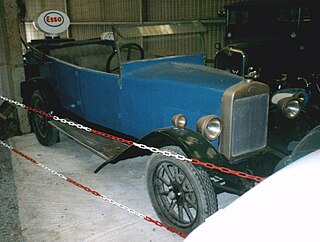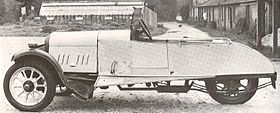
Reliant Motor Company was a British car manufacturer based in Tamworth, Staffordshire, England. It was founded in 1935 and ended car production in 2002, the company had been known as "Reliant Motor Company" until the 1990s when it became "Reliant Motors" and then finally became "Reliant cars LTD" after production had ended of the Robin as the company was restructured to be a car import business. It's now a dormant company and the only entity left is a separate parts company created called Reliant Partsworld who produce parts for Reliant vehicles.

The Morgan Motor Company is a English motor car manufacturer owned by Italian investment group Investindustrial. It was founded in 1910 by Henry Frederick Stanley Morgan.
Coventry Victor was a British motorcycle and car manufacturer. Originally Morton & Weaver, a proprietary engine manufacturer in Hillfields, Coventry, founded in 1904, the company changed its name to Coventry Victor Motors in 1911. The company closed in 1971.

Singer Motors Limited was a British motor vehicle manufacturing business, originally a bicycle manufacturer founded as Singer & Co by George Singer, in 1874 in Coventry, England. Singer & Co's bicycle manufacture continued. From 1901 George Singer's Singer Motor Co made cars and commercial vehicles.

The Austin 7 is an economy car that was produced from 1923 until 1939 in the United Kingdom by Austin. It was nicknamed the "Baby Austin" and was at that time one of the most popular cars produced for the British market and sold well abroad. Its effect on the British market was similar to that of the Model T Ford in the US, replacing most other British economy cars and cyclecars of the early 1920s. It was also licensed and copied by companies all over the world. The first BMW car, the BMW Dixi, was a licensed Austin 7. In France they were made and sold as Rosengarts, and in the United States they were built by the American Austin Car Company. In Japan, Nissan also used the 7 design as the basis for their first cars, although not under licence. This eventually led to a 1952 agreement for Nissan to build and sell Austins in Japan under the Austin name.
Wooler was a British manufacturer of motorcycles and automobiles, founded by engineer John Wooler in 1911 based in Alperton, Middlesex. The company became known for its unconventional designs which included several fore-and-aft twins, a vertical camshaft single cylinder machine, a transverse-four beam engine, and a transverse flat four. Most machines possessed Wooler's enduring design features of a petrol tank which extended past the steering head.

Coventry Premier Limited owned a British car and cyclecar manufacturing business based in Coventry from 1912 to 1923. It changed its name from Premier Cycles to Coventry Premier Ltd in November 1914.
The Elfe was a French automobile, manufactured in Lavallois, Paris, from 1919 until about 1925 by Ateliers Defrance Freres. The company was founded by M. Eugene Mauve, who was also the instigator of the Bol d'Or race for cyclecars and latterly motorcycles, now held at the Le Mans circuit in France. During its brief life, the company entered numerous races, under various names including ELFE, Elfe-Anzani, Elfe-DeFrance and Mauve.
The Rover 8 was a small single-cylinder 8 hp 1327 cc car made by the British Rover car company. It was Rover's first production car. It was remarkable for being supported by a backbone chassis rather than a conventional ladder frame. The first model was manufactured from 1904 to 1912, A Daimler-Knight sleeve-valve engine option was available in 1911 and 1912.
The Perry was a British car made by the Perry Motor Company based in Tyseley, Birmingham who made cars between 1913 and 1916.
The Hampton was a British car made by the Hampton Engineering Company which was based in Kings Norton, Birmingham from 1912 to 1918 and at Dudbridge in Stroud, Gloucestershire from 1918 to 1933

The Rover 12 was a name given to several medium-sized family cars from the British Rover car company between 1905 and 1948.
The HP was a British three-wheeled cyclecar made from 1926 until 1928 by Hilton-Peacey Motors of Woking, Surrey.
The Dewcar was a British four-wheeled cyclecar made from 1913 to 1914 by D.E.W. Engineering Co Ltd of Eynsford, Kent. The car was designed by Harold E. Dew and was developed through a series of one-offs starting in 1910.

The Little Midland or LM was a British 4-wheeled cyclecar made from 1910 to 1922 by the Little Midland Light Car Co Ltd in various places in Lancashire.

The Warren-Lambert Engineering Co. Ltd. was a British automobile manufacturer that was established from 1912 to 1922 in Richmond, then in Surrey. A. Warren Lambert, was an agent for Morgan cars in Putney which he also raced. In 1912 he designed and started to manufacture a two-seat four-wheel cyclecar from premises in Uxbridge Road, Shepherd's Bush. It was well received and around 25 cars a week were being made.
M.Tholomé was an automobile manufacturer based on the north side of Paris between 1919 and 1922, which produced cyclecars.
The Singer Ten name was used for several automobiles produced by Singer Motors between 1912 and 1949. The "Ten" in the name referred to the taxation horsepower rating in the United Kingdom.
The Day-Leeds was a British automobile manufactured by Job Day & Sons of Leeds, Yorkshire.

The Rhode was a British car made from 1921 to 1930. Mead and Deakin Ltd had started in business making cycle and motor cycle components. They also made the "Canoelet" sidecar. In 1912 they made at least two cyclecars under the name of Medea with 1244cc Chapuis-Dornier engines but these did not go into series production.









